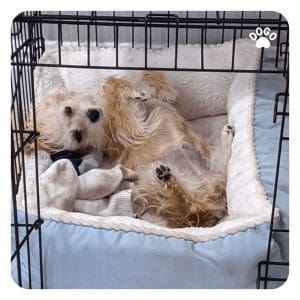
First of all, crate training prevents peeing in the house and second of all, it allows the dog to have a comfortable, undisturbed place to sleep. There is also less risk of destruction or confrontation with other family pets. Although it is an excellent tool if well used, you should know that it is not mandatory.
One of the other benefits of crate training is that it helps the dog to become familiar with a confined space. This is particularly important if you have to travel with your dog, as they may need to be placed in a crate during transport. Crate training can also help to reduce anxiety and stress in dogs, especially those that suffer from separation anxiety. By providing a safe and comfortable space that they can retreat to, dogs are more likely to feel secure and relaxed when left alone. Additionally, crate training can be useful for veterinary visits or grooming sessions, as the dog will be more accustomed to being confined in a small space. However, if you choose to introduce the crate, here’s what you need to know to get your dog to sleep in it at night.
Comfort First
Before the dog even arrives, the first thing to do is to ensure that the crate is comfortable. Make sure it’s big enough and put a soft bed inside. It is also recommended to have a water bowl that attaches to the bars to avoid spilling water everywhere. Finally, it is helpful for some dogs to cover the crate with a blanket to give a puppy the impression of a comfortable little cocoon away from distractions.
For the first few days and nights, leave the crate in your bedroom with the door open (close your bedroom door). It will allow you to hear if there is a problem and reassure your dog because they will be with you, and they will have the choice to sleep inside the crate. Typically, they will stay inside the crate if it is comfortable. Having the crate in the bedroom also helps to establish a bond between the dog and the owner. Dogs are social animals and thrive on human interaction, so being close to their owner can help to reduce their anxiety.
Learning to Love the Crate

It’s also important to note that crate training should never be used as a punishment. The crate should always be associated with positive experiences, such as rewards and treats. If a dog is forced into the crate or punished while inside, they may become fearful and distressed, which can lead to behavioural problems. By using positive reinforcement techniques, such as praise and treats, dogs are more likely to view the crate as a safe and comfortable space.
Gradual Habituation
Then you need to gradually get them used to closing the door and being alone inside the crate. Don’t just close the door when it’s time to leave the house for the day or before you go to bed, or your dog will start to dislike their crate, as it always means a long separation. Instead, play games with your dog: ask them to go inside the crate, give treats, close the door, and open it after a few seconds! It will become a game for your dog to get in and out.
Eventually, you will be able to leave your dog alone in it for longer. The first few times you want to leave the crate door closed longer, give your dog a tasty treat to chew on and close the door while they eat it. They will have such a good time that they may fall asleep there! It is when you have reached this stage that you can begin to close the door longer: for the night or when you leave the house, for example.
You should also vary the length of time that your dog is inside the crate, so they don’t get bored or anxious. It’s important to note that crate training should never be used as a substitute for exercise or human interaction. Dogs still need plenty of exercise and attention, even if they are spending some time in a crate. Finally, it’s important to remember that every dog is different, and some may take longer to become comfortable with crate training. Be patient and consistent, and your dog will eventually learn to love their crate.







